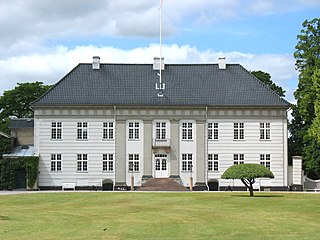
Temperate rainforests are rainforests with coniferous or broadleaf forests that occur in the temperate zone and receive heavy rain.

The Appalachian–Blue Ridge forests are an ecoregion in the Temperate broadleaf and mixed forests Biome, in the Eastern United States. The ecoregion is located in the central and southern Appalachian Mountains, including the Ridge-and-Valley Appalachians and the Blue Ridge Mountains. It covers an area of about 61,500 square miles (159,000 km2) in: northeast Alabama and Georgia, northwest South Carolina, eastern Tennessee, western North Carolina, Virginia, Maryland, and central West Virginia and Pennsylvania; and small extensions into Kentucky, New Jersey, and New York.

The woodlands of the Iberian Peninsula are distinct ecosystems on the Iberian Peninsula. Although the various regions are each characterized by distinct vegetation, the borders between these regions are not clearly defined, and there are some similarities across the peninsula.

Riis Skov is a forest and park in Århus, Denmark. It is located south of the district of Risskov, along the Bay of Aarhus.

The Ancient Forest Alliance is a grassroots environmental organization in British Columbia, Canada. It was founded in January 2010, and is dedicated to protecting British Columbia's old-growth forests in areas where they are scarce, and ensuring sustainable forestry jobs in that province.

Corselitze, or Korselitse, is a manor house on the island of Falster in the south-east of Denmark. The Neoclassical house was built in 1777 by Johan Frederik Classen, who at the time of his death founded Det Classenske Fideicommis, which owns the estate today.

Hesnæs is a little fishing village located 12 kilometres (7.5 mi) southeast of Stubbekøbing on the Danish island of Falster. Its distance from Copenhagen is 125.4 km. It is best known for its thatched, straw-clad houses, not found elsewhere in Denmark.
Orupgaard is a manor house located 6 kilometres (3.7 mi) east of Nykøbing and 3 kilometres (1.9 mi) north of Idestrup on the Danish island of Falster. With a history dating from the 13th century, Orupgaard today manages over 1,200 hectares of farmland and forest as well as an equestrian facility at Brændte Ege Avlsgaard.

Johan Frederik Classen, frequently also J. F. Classen, was a Danish-Norwegian industrialist, major general, landowner and founder of Det Classenske Fideicommis. He served as chancellery adviser to King Frederik V. Classen built the manor house Arresødal in 1773, he renovated the Neoclassical manor house Corselitze in 1777, and built the General's Summerhouse by the Corselitze Forest.

The Classen Library, was a public library in Copenhagen, Denmark. It was created from the private book collection of Johan Frederik Classen, at the time of his death in 1792. It was the third largest library in the city, surpassed only by the Royal Danish Library and Copenhagen University Library and existed until 1867 when it was merged with the latter.

Aastrup Church, located on the top of a steep hill in the village of Aastrup, 6 kilometres (3.7 mi) southwest of Stubbekøbing on the Danish island of Falster, dates from c. 1200. Built in the Late Romanesque style, it has frescos from the 13th and 15th centuries.
Det Classenske Fideicommis is a Danish charitable foundation. By testament in 1789 and his codicil of March 23, 1792, the industrialist Major General Johan Frederik Classen left behind his wealth and possessions as a fund, among other things, to "alleviate poverty and misery". It grants about 2 million kroner ($340,000) annually.

Peter Hersleb Classen, frequently also P. H. Classen, was a Norwegian-Danish statesman and director of Det Classenske Fideicommis.

Generalens Lysthus is a small, thatched cottage in Tromnæs Forest on the Danish island of Falster. It was built in 1786 by the industrialist Johan Frederik Classen who also built nearby Corselitze.

Alf Cock-Clausen was a Danish architect. He was active during the transition from Neoclassicism to Functionalism and many of his works show influence from Art Deco. His factory for the distillery De Danske Spritfabrikker at Aalborg's harbour front was declared a Danish Industrial Heritage Site in 2009.

Mols Bjerge National Park or Nationalpark Mols Bjerge is a Danish national park in the area known as Mols Bjerge in Syddjurs Municipality, Central Jutland, inaugurated on 29 August 2009. The protected area, measures 180 square kilometres (69 sq mi) in size. The Mols Hills, reaching a height of 137 metres (449 ft), are centrally located in the park, and take up 2,500 ha. "More than half of all wild Danish plant species" can be found at Mols Bjerge.

Frederik Vilhelm Tvede was a Danish architect.

True Skov is a 385 hectares woodland, west of Skjoldhøjkilen in Aarhus, Denmark.

The Jan von Osten House is a listed Baroque style property at the corner of Amaliegade and Toldbodgade in the Frederiksstaden neighbourhood of central Copenhagen, Denmark. The building was the city home of Johan Frederik Classen from 1770. On his death. it was endowed to the Det Classenske Fideicommis which was headquartered in the building until 1970. The building was listed on the Danish registry of protected buildings and places in 1918.

Moseby Rectory, situated at Moseby, approximately 2 km southeast of Aastrup Church, is the rectory of Åstrup Parish on Falster, Guldborgsund Municipality, Denmark. The half-timbered and thatched rectory traces its history back to the 1590s but owes its current appearance to a renovation in 1770 as well as later additions.The four-winged complex was listed in the Danish registry of protected buildings and places in 1945. In 2016, Moseby Rectory was voted the most attractive rectory in Denmark in a vote arranged by Bygningskultur Danmark. The rectory is also notable for its large landscape garden with many exotic trees as well as a pond, an orchard and a boxwood-hedged rose garden.




















